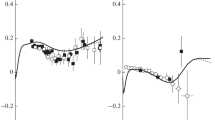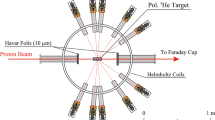Abstract
Various spin observables (analyzing powers and spin-correlation parameters) in pd elastic scattering at \(T_p = 800\)–1000 MeV are analyzed within the framework of the refined Glauber model. The theoretical model uses as input spin-dependent NN amplitudes obtained from the most recent partial-wave analysis and also takes into account the deuteron D wave and charge-exchange effects. Predictions of the refined Glauber model are compared with the existing experimental data. Reasonable agreement between the theoretical calculations and experimental data at low momentum transfers \(|t| \lesssim 0.2\) (GeV/c)\(^2\) is found for all observables considered. Moderate discrepancies found in this region are shown to be likely due to uncertainties in the input NN amplitudes. Qualitative agreement at higher momentum transfers is also found for most observables except the tensor ones with mixed x and z polarization components. Possible reasons for observed deviations of the model calculations from the data at \(|t| > 0.2\) (GeV/c)\(^2\) are discussed.









Similar content being viewed by others
Data Availability Statement
This manuscript has no associated data or the data will not be deposited. [Authors’ comment: This is a theoretical study. No new experimental data have been listed.]
Notes
One should note that the above relations are valid for arbitrary q not only in the center-of-mass, but also in the Breit frame which is convenient to use for describing pd (as well as ed) scattering when going beyond the fixed-scatterer approximation. At small transferred momenta, the Breit frame almost coincides with the laboratory frame.
All observables of the type \(C(\alpha ,\beta ,0,0)\) are sometimes denoted in the literature as \(A_{\alpha \beta }\) (see, e.g., [44]); in this case, spin-correlation parameters are called correlated analyzing powers, though this notation is far less common.
A lot of measurements were actually performed on dp rather than pd scattering. The Madison frame for dp scattering is related to that for pd scattering by reflection of two axes \(x \rightarrow -x\), \(z \rightarrow -z\), which does not affect the definition of observables.
The available data include also dp elastic scattering measurements at the incident deuteron energies which are twice the proton energies considered here.
The single-scattering contribution is plotted in Figs. 1, 2, 3, 4 and 5 up to \(|t| = 1\) (GeV/c)\(^2\), though the Gaussian parametrization [31] used in calculations reproduces NN helicity amplitudes only for \(q \le 0.7\) GeV/c (\(|t| \le 0.5\) (GeV/c)\(^2\)) and may deviate from them at higher momentum transfers. Nevertheless, pd elastic scattering at \(|t|> 0.35\) (GeV/c)\(^2\) is dominated by the double-scattering term, which contains NN amplitudes in the vicinity of |t|/4, so, the results of the full calculations correspond to the correct NN input until \(|t| = 1\) (GeV/c)\(^2\) and higher.
Here and further on we do not consider the region \(0 \le |t| \lesssim 0.04\) (GeV/c)\(^2\) where Coulomb effects neglected in our model calculations are significant in pd scattering.
The amplitudes \(C'_N\) which enter the representation (5) of the total NN amplitudes in the laboratory frame are modified accordingly: if to denote the modified amplitudes \(C_N\) as \({\tilde{C}}_N\), then the modified amplitudes \(C'_N\) are \({\tilde{C}}'_N = C'_N+({\tilde{C}}_N-C_N)\).
References
C. Wilkin, Eur. Phys. J. A 53, 114 (2017). arXiv:1611.07250
C. Fritzsch et al., Phys. Lett. B 784, 277 (2018). arXiv:1805.12499
D. Mchedlishvili et al., Nucl. Phys. A 977, 14 (2018). arXiv:1805.05778
S. Barsov et al., Eur. Phys. J. A 54, 225 (2018). arXiv:1808.01792
K. Sekiguchi et al., Phys. Rev. C 83, 061001 (2011). arXiv:1106.0180
K. Sekiguchi et al., Phys. Rev. C 89, 064007 (2014)
K. Sekiguchi et al., Phys. Rev. C 96, 064001 (2017)
V.V. Glagolev, V.P. Ladygin, N.B. Ladygina, A.A. Terekhin, Eur. Phys. J. A 48, 182 (2012)
A. Terekhin et al., EPJ Web Conf. 138, 03012 (2017)
A.A. Terekhin et al., Phys. Atom. Nucl. 80, 1061 (2017)
A.A. Terekhin et al., Yad. Fiz. 80, 594 (2017)
P.K. Kurilkin et al. (HADES) PoS Baldin-ISHEPP-XXI, 040 (2012)
P.K. Kurilkin et al., Phys. Lett. B 715, 61 (2012). arXiv:1207.3509
W. Glöckle, H. Witala, D. Huber, H. Kamada, J. Golak, Phys. Rep. 274, 107 (1996)
V.I. Komarov, G.E. Kosarev, G.P. Reshetnikov, O.V. Savchenko, Yad. Fiz. 16, 234 (1972)
L.S. Azhgirei et al., Phys. Atom. Nucl. 61, 432 (1998)
L.S. Azhgirei et al., Yad. Fiz. 61, 494 (1998)
V. Punjabi et al., Phys. Lett. B 350, 178 (1995)
J. Arvieux et al., Nucl. Phys. A 431, 613 (1984)
P. Berthet et al., J. Phys. G 8, L111 (1982)
Yu.N. Uzikov, Phys. Part. Nucl. 29, 583 (1998)
Yu.N. Uzikov, Fiz. Elem. Chast. Atom. Yadra 29, 1405 (1998)
R.J. Glauber, Phys. Rev. 100, 242 (1955)
V. Franco, R.J. Glauber, Phys. Rev. 142, 1195 (1966)
G. Alberi, M. Bleszynski, T. Jaroszewicz, Ann. Phys. 142, 299 (1982)
E. Bleszynski, M. Bleszynski, T. Jaroszewicz, AIP Conf. Proc. 150, 1208 (1986)
E. Bleszynski, M. Bleszynski, T. Jaroszewicz, Phys. Rev. Lett. 59, 423 (1987)
N.B. Ladygina, Phys. Atom. Nucl. 71, 2039 (2008). arXiv:0705.3149
N.B. Ladygina, Eur. Phys. J. A 42, 91 (2009). arXiv:0906.1910
D.R. Harrington, Phys. Rev. 184, 1745 (1969)
M.N. Platonova, V.I. Kukulin, Phys. Rev. C 81, 014004 (2010). [Erratum: Phys. Rev. C 94, 069902(E) (2016)]. arXiv:1612.08694
M.N. Platonova, V.I. Kukulin, Phys. Atom. Nucl. 73, 86 (2010)
M.N. Platonova, V.I. Kukulin, Yad. Fiz. 73, 90 (2010)
R.A. Arndt, W.J. Briscoe, I.I. Strakovsky, R.L. Workman, Phys. Rev. C 76, 025209 (2007). arXiv:0706.2195
All SAID PWA solutions and \(NN\) elastic scattering database. http://gwdac.phys.gwu.edu
R. Machleidt, Phys. Rev. C 63, 024001 (2001). arXiv:nucl-th/0006014
C. Elster, T. Lin, W. Glöckle, S. Jeschonnek, Phys. Rev. C 78, 034002 (2008)
A.A. Temerbayev, YuN Uzikov, Phys. Atom. Nucl. 78, 35 (2015)
A.A. Temerbayev, YuN Uzikov, Yad. Fiz. 78, 38 (2015)
Yu.N. Uzikov, J. Haidenbauer, Phys. Rev. C 87, 054003 (2013)
R.L. Workman, W.J. Briscoe, I.I. Strakovsky, Phys. Rev. C 94, 065203 (2016). arXiv:1609.01741
E. Winkelmann et al., Phys. Rev. C 21, 2535 (1980)
F. Irom, G.J. Igo, J.B. McClelland, C.A. Whitten, M. Bleszynski, Phys. Rev. C 28, 2380 (1983)
D.L. Adams et al., Nucl. Phys. A 480, 530 (1988)
A. Rahbar et al., Phys. Lett. B 194, 338 (1987)
M. Haji-Saied et al., Phys. Rev. C 36, 2010 (1987)
V. Ghazikhanian et al., Phys. Rev. C 43, 1532 (1991)
G. Igo et al., Phys. Rev. C 38, 2777 (1988)
E. Guelmez et al., Phys. Rev. C 45, 22 (1992)
T.H. Sun et al., Phys. Rev. C 31, 515 (1985)
I. Savin et al., Eur. Phys. J. A 52, 215 (2016)
C. Sorensen, Phys. Rev. D 19, 1444 (1979)
G.W. Bennett et al., Phys. Rev. Lett. 19, 387 (1967)
N. Dalkhazhav et al., Sov. J. Nucl. Phys. 8, 196 (1969)
N. Dalkhazhav et al., Yad. Fiz. 8, 342 (1968)
G.N. Velichko et al., Sov. J. Nucl. Phys. 47, 755 (1988)
G.N. Velichko et al., Yad. Fiz. 47, 1185 (1988)
E. Guelmez et al., Phys. Rev. C 43, 2067 (1991)
Z. Bagdasarian et al., Phys. Lett. B 739, 152 (2014). arXiv:1409.8445
Yu. Uzikov, C. Wilkin, Phys. Lett. B 793, 224 (2019). arXiv:1902.03596
C. Wilkin, private communication
R.B. Wiringa, V.G.J. Stoks, R. Schiavilla, Phys. Rev. C 51, 38 (1995). arXiv:nucl-th/9408016
V.I. Kukulin, V.N. Pomerantsev, M. Kaskulov, A. Faessler, J. Phys. G 30, 287 (2004). arXiv:nucl-th/0308059
M.N. Platonova, V.I. Kukulin, J. Phys. Conf. Ser. 381, 012110 (2012)
Acknowledgements
The authors appreciate fruitful discussions with Colin Wilkin, who carefully read the initial version of the manuscript and made valuable comments and suggestions. The work was supported by the Russian Foundation for Basic Research, Grants Nos. 19-02-00014 and 19-02-00011, and the Foundation for the Advancement of Theoretical Physics and Mathematics “BASIS”.
Author information
Authors and Affiliations
Corresponding author
Additional information
Communicated by Pierre Capel.
Appendix A: Transformation of polarization observables in \(\varvec{pd}\) elastic scattering to the Madison frame
Appendix A: Transformation of polarization observables in \(\varvec{pd}\) elastic scattering to the Madison frame
In this appendix we give the explicit formulas which should be applied to transform the pd elastic spin observables from the \(xyz = \{{\hat{q}}{\hat{n}}{\hat{k}}\}\) frame used in deriving the formalism of the refined Glauber model to the \(xyz = \{{\hat{S}}{\hat{N}}{\hat{L}}\}\) (Madison) frame conventionally used in experiments (see definitions in Sect. 2).
We have the following expressions for the analyzing powers:
and for the spin-correlation parameters:
We should note here that we did not transform the analyzing powers to the Madison frame in our previous work [31,32,33]. However, when compared the theoretical predictions to experimental data, we inverted the sign of vector analyzing powers \(A_y^p\) and \(A_y^d\). We also considered tensor analyzing powers \(A_{yy}\) (which is the same in both coordinate frames) and \(A_{xx}\) (which is changed only slightly by Eq. (A.1) in the forward hemisphere), so that there was no significant error in comparing these observables to those measured in the Madison frame. The only analyzing power that changes its behavior substantially under the transformation (A.1) is \(A_{xz}\) (due to an admixture of large \(A_{xx}\)), which was not considered in our previous works.
The expressions for some of the above observables in terms of 18 pd amplitudes derived directly in the Madison frame and the relations of these amplitudes to our ones \(A_1\)–\(A_{12}\) are to be found in Refs. [38, 39].
We also give here an alternative representation of the pd elastic scattering amplitude in the \(\{{\hat{q}}{\hat{n}}{\hat{k}}\}\) frame, which has a more symmetric form than Eq. (4):
The set of invariant amplitudes \(M_1\)–\(M_{12}\) (multiplied by a standard normalization factor \(8p\sqrt{\pi s}\)) was used in, e.g., Refs. [21, 22] (note, however, that the direction of the unit vector \({\hat{n}}\) was chosen there opposite to ours). These amplitudes are related to our ones, \(A_1\)–\(A_{12}\), as follows:
The pd elastic observables expressed in terms of the amplitudes \(M_1\)–\(M_{12}\) look simpler than those given by Eq. (4) of Ref. [31] and Eq. (8) of the present paper. In particular, interference between different amplitudes vanishes in the expression for the differential cross section. On the other hand, such a representation is less transparent in the sense that there are three large amplitudes \(M_1\), \(M_3\) and \(M_5\) instead of only one dominant amplitude \(A_1\) at low momentum transfers.
Rights and permissions
About this article
Cite this article
Platonova, M.N., Kukulin, V.I. Theoretical study of spin observables in \(\varvec{pd}\) elastic scattering at energies \(\varvec{T_p = 800}\)–\(\varvec{1000}\) MeV. Eur. Phys. J. A 56, 132 (2020). https://doi.org/10.1140/epja/s10050-020-00120-0
Received:
Accepted:
Published:
DOI: https://doi.org/10.1140/epja/s10050-020-00120-0




